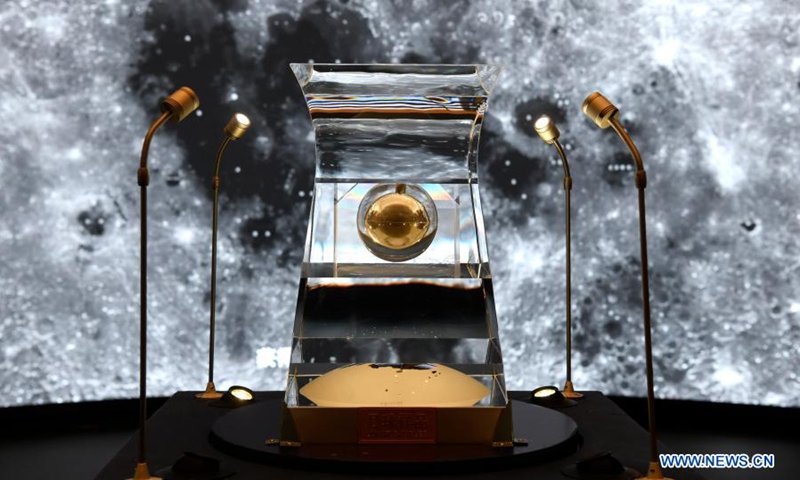
The lunar samples No. 001 brought back by China's Chang'e-5 probe is displayed at the National Museum of China in Beijing, capital of China, Feb. 27, 2021. An exhibition displaying the lunar samples No. 001 brought back by China's Chang'e-5 probe is held here on Saturday.(Photo: Xinhua)
China has determined more than 40 chemical elements in the lunar soil samples brought back by the Chang'e-5 mission with nuclear technology, a scientist team revealed on Sunday. The discovery will serve as an important reference for the study of the formation and evolution of the Moon and will also boost the utilization of lunar resources, experts said.
The research team from China Institute of Atomic Energy (CIAE), affiliated with the China National Nuclear Corporation, used neutron activation analysis and found that the chemical substances contained in the Chang'e-5 lunar samples were very different from those on Earth, China Central Television reported on Sunday.
"We mainly used nuclear reactors to study the samples, accurately testing over 40 chemical elements including macroelements, microelements, and trace elements in them," Guo Bing, head of the institute of nuclear physics at CIAE, was quoted as saying in the report.
Experts noted that as the lunar soil is extremely precious, non-destructive studies of the samples can improve the efficiency of its use. In particular the neutron activation analysis, which has a high degree of accuracy, can not only determine exactly which elements the moon soil contain without destroying its morphology, but also tell the concentration by measuring the rays reflected by each element.
"For example, we can extract more than 30 kilograms of titanium from one ton of lunar samples, the content of which is more than six times the average of titanium on Earth. It provides very important basic data for our future exploration on the Moon and boosts the utilization of resources," Guo said.
The research team further noted that they will study the isotopic content of the lunar samples, which according to Yang Yuguang, vice chairman of the Space Transportation Committee with the International Astronautical Federation, will serve as an important reference for the study of the formation and evolution of the Moon.
"Most of the elements on Earth can be found on the Moon, but there are some differences in the isotopic content and a few different materials can only be found on the Moon. Among current Moon formation theories, the findings can best illustrate the giant-impact theory, which proposes that the Moon formed during a collision between the Earth and another small planet, about the size of Mars. However, this still needs a great amount of studies to prove," Yang told the Global Times on Sunday.
Yang further elaborated that the study of Moon samples is currently focused on finding water and Helium-3. "Scientists are studying whether the water on the Moon surface can be used, but so far all the samples retrieved have very little quantity of water. Explorations of the North and South Pole on the Moon may find soils that contain more water. Helium-3, one of the most ideal fuels for nuclear fusion, is very scarce on Earth but abundant on the Moon, which is of far-reaching significance for the sustainable development of human energy in the future."




